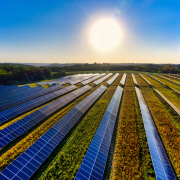AgriSolar News Roundup: Crops and Livestock in AgriSolar, AgriSolar Adds Value to Low-Yield Crops, Food Security in Brazil Using AgriSolar
AgriSolar Shown to be Ideal for Various Crops and Livestock
“Agrivoltaics, the practice of producing food in the shade of solar panels, is an innovative strategy that combines the generation of photovoltaic electricity with agricultural land use. The outcome is an optimized relationship between food production, water, and energy – the so-called Food-Energy-Water Nexus.
According to research by Prof. Greg Barron-Gafford (University of Arizona), potential crops include hog peanut, alfalfa, yam, taro, cassava, sweet potato, and lettuce. In a 2019 study, he analyzed cherry tomatoes, chiltepin peppers, and jalapeno production in combination with solar production. Cherry tomato production doubled under solar panels, while chiltepin pepper production tripled.
Sheep seem to be the best livestock for agrivoltaics. They do an excellent job of keeping vegetation down, which lowers maintenance and long-term operational costs. According to research by Cornell University, sheep grazing resulted in “2.5 times fewer labor hours than mechanical and pesticide management on-site.” – HDI
AgriSolar Adds Value to Low-Yield Crops
“A group of 35 French agricultural entrepreneurs decided to change their agricultural practices to adapt to the low quality of their groundwater and chose agrivoltaics as a way to compensate for crop yield losses.
In May, we experienced an episode of high heat and drought. Under the panels, which retained the evapotranspiration of the plants, we found that the plants were greener and better developed than between the rows. So, we think the return will be higher than what we originally estimated,” Jean-Michel Lamothe, a farmer in France’s Lands department and vice president of the French Federation of agrivoltaic producers (FFPA), told PV Magazine.
“We decided to grow plants rich in omega-3s, which respond well to our water quality problem and the climate of the region: flax, chia, camelina, rapeseed, and sunflower,’ he further explained. ‘And we will compensate for the drop in productivity with revenues from photovoltaics.’” – PV Magazine
AgriSolar Benefits Crops in Water-Stressed Regions of Brazil
“Brazil’s first agrivoltaic system is called Ecolume. It was developed by a network of more than 40 Brazilian researchers and funded by CNPq, the National Council for Scientific and Technological Development.
The Ecolume Agrivoltaic System (SAVE) makes the most of the scant local water resources by reusing water and collecting rainwater. It consists of 10 photovoltaic panels that cover 24 square meters (258 square feet), installed at a height of 2 meters (6 feet) above the ground.
In simulations carried out by Ecolume researchers, the agrivoltaic system produced up to 70% more vegetables and lowered the need for water, depending on the crop and environment. A study carried out at the University of Arizona, in the southwestern U.S. — a region that also experiences water scarcity — showed yields two to three times higher for some fruits and vegetables planted under solar panels. The SAVE water recycling and treatment systems also showed a 90% savings in water used for irrigation.” – Mongabay



